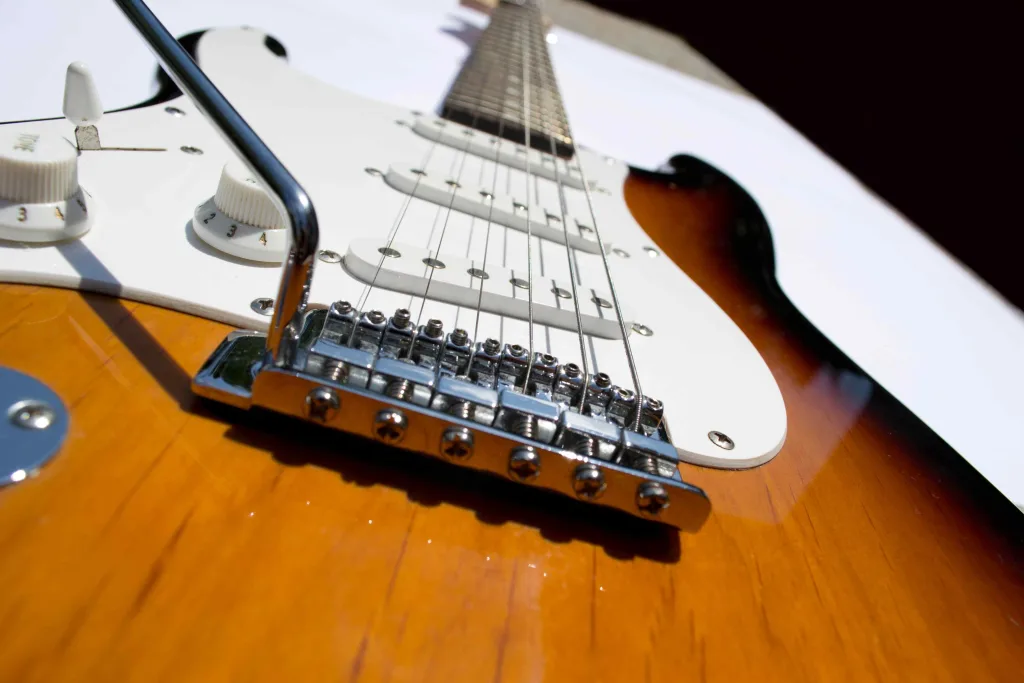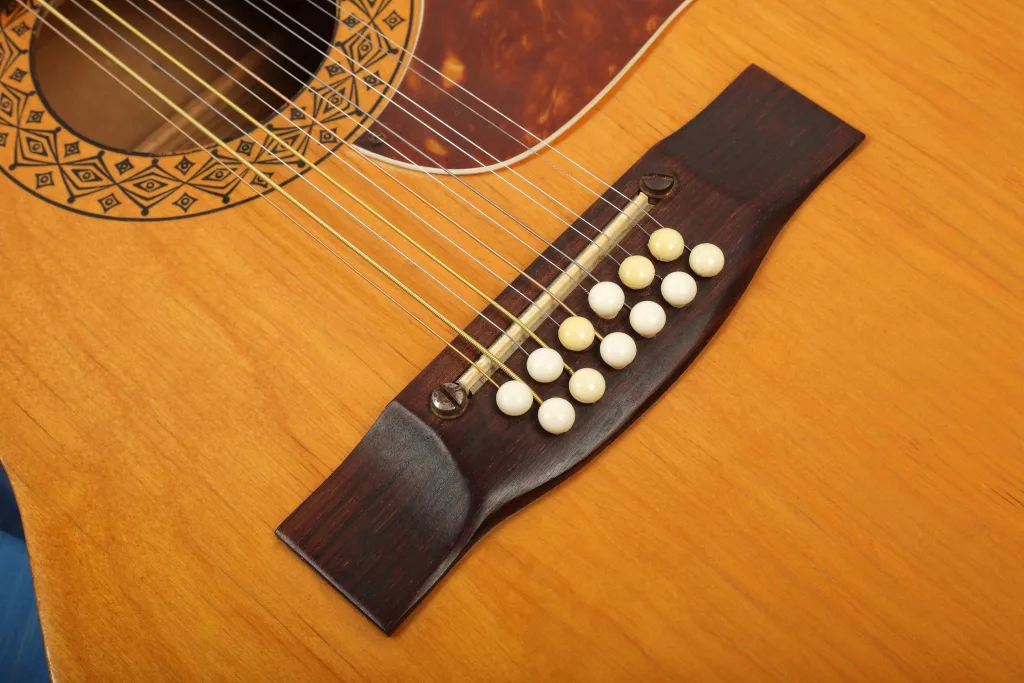Playing a well-intonated guitar is essential for any musician. Not only does it make your music sound great, but it also makes playing easier and more enjoyable.
But what exactly is intonation? And how do you adjust it on your guitar?
In this article, we’ll explore everything you need to know about guitar intonation, from understanding the concept to adjusting and checking your own instrument.
Let’s dive in!
What is Guitar Intonation?
Guitar intonation is the tuning of a guitar string across its full length. It involves adjusting the tension of each string until all notes on the fretboard are in tune.
Good intonation means that when you play any note, it will be in tune regardless of where you are on the neck. Bad intonation means that some notes will be sharp or flat depending on which part of the neck they’re played at.
Adjusting guitar intonation requires careful adjustments to ensure all strings have accurate tuning tensions and bridge saddles are set correctly. This can either be done by yourself or by taking your guitar to a professional luthier for adjustment.
With a little bit of patience and know-how, anyone can achieve good intonation on their instrument and enjoy improved sound quality as a result!
Read more about guitar intonation.
How To Adjust Intonation on Your Guitar
Adjusting your guitar’s intonation is an important part of keeping it in top playing condition. To do this, you’ll need to make sure the truss rod is adjusted correctly, and that the bridge saddle is where it needs to be.
Depending on whether you have an electric or acoustic guitar, adjusting the bridge saddle will differ slightly.
For electric guitars, there are several different types of bridges which require slightly varied procedures, while acoustics only require a few simple steps.
How to adjust the truss rod
Tightening the truss rod can help your guitar’s neck bend back into place. To adjust the truss rod, first lay the guitar on a flat surface and check to see if the neck is bending away from, towards, or straight across the strings.
Then, look for an entry point near the headstock of your guitar where you can access it. Once you’ve found it, turn it either right to tighten or left to loosen depending on what your neck needs.
After making adjustments, tune your strings and wait two to four days before checking intonation again.
Remember: check for neck position, find entry point, and turn right/left accordingly.
Doing this will help ensure that your guitar is in tune with perfect intonation!
How to adjust different types of electric guitar bridge saddles

If you’re looking to adjust the intonation of your electric guitar, it’s important to first determine what type of bridge saddle your instrument has. Understanding how each type of bridge functions will help ensure that you’re able to properly adjust your guitar’s intonation and get the sound that you want.
Fender-style Bridges
Fender-style bridges allow you to fine-tune your string length with a simple twist of the screw, adding depth and clarity to your sound.
To adjust the intonation on this type of bridge, you’ll need to locate each saddle which is connected to the bridge by a screw.
Turning the screw clockwise increases the length of the guitar string and will improve intonation if the fretted 12th fret note is sharp. For flat notes, turn it anti-clockwise which will decrease its length.
When making adjustments, be sure to only make small changes at a time and then re-tune and check before continuing. This way you can dial in your desired tone with precision.
Gibson style Bridges
Gibson-style bridges allow you to tweak your string length with a quick twist of the screw, giving your sound more depth and clarity.
To adjust intonation on this type of bridge, you’ll need to locate the roller saddles on the other side of the bridge.
Once you’ve found them, look for the screws that adjust their position.
Turning them clockwise will decrease the string length if a fretted note is flat, and anti-clockwise will increase it if it’s sharp.
Remember to reduce tension when adjusting to prevent damage to both strings and saddles.
PRS Wraparound or Stoptail Bridges
If you have a PRS, you may have a wraparound or stoptail bridge. These bridges require a slightly different approach when it comes to adjusting the intonation.
On these bridges, you need to adjust the individual screws accessed from the other side of the bridge. It’s a little awkward as you need to fit your screwdriver under the strings, but if done correctly, it can help improve intonation across each string.
You’ll also find two adjustment screws on both ends of the bridge that can be used to angle it left or right in order to improve intonation overall.
Floyd Rose Bridges
If you’re looking for a bridge that gives you more control over intonation, consider going with a Floyd Rose. It’s the ultimate way to ‘tune to your own tune’! The nuts on each saddle give you the ability to move them back or forward and re-tighten them.
You’ll need to detune and re-tune your strings multiple times while adjusting the saddle position of each string, which can be cumbersome. But once you’ve found the perfect position for each string, it’ll surely be worth the effort.
Adjusting acoustic guitars saddles

On acoustic guitars, you can’t easily adjust the intonation like you can with an electric guitar. However, there are a few ways to tweak it. For example, you could use a compensated saddle or even file down the existing one.
The compensated saddle is designed with slight adjustments for each string that allow for greater control over intonation. This can be especially useful if your acoustic guitar has been set up with poor intonation from the factory.
Filing down your existing saddle is also an option if you have some experience in making adjustments and are careful not to over-file it. It’s important to check the action and truss rod settings before attempting either of these methods to make sure they aren’t causing any problems with your intonation.
How To Check Intonation on Your Guitar
Checking your guitar’s intonation is easy – just compare the open string pitch to the same note at the 12th fret.
Here are some key points to remember:
- Play an open string and check the note for pitch accuracy on a tuner.
- Let the open-string ring while you play the same note on the 12th fret.
- Test a harmonic by playing an open string, then playing a harmonic at the 12th fret.
- Check each of your strings at the 12th fret.
- Adjust intonation if fretted or harmonic notes are several cents sharp or flat.
What can cause guitar intonation problems?
Intonation problems on your guitar can be caused by a few different things.
Here are some common ones:
The guitar action is too high or too low
If your guitar’s action is too high or too low, it can cause intonation issues – so take a look and see if you need to make any adjustments.
Here are 4 steps to follow when adjusting the action of your guitar:
- Measure the string height at the 12th fret – for an acoustic guitar, this should be 2.6 mm and 1.8 mm for an electric guitar.
- Adjust each saddle bridge string until they all match the desired measurement.
- Check that there’s no buzzing or other noise coming from the strings as you play them.
- Make sure that all notes on each string are in tune with a tuner or pitch pipe.
If necessary, use shims or sandpaper to raise or lower individual saddles until everything is perfect – just remember not to make any drastic changes!
Worn or rusty strings
If you’re noticing problems with the intonation of your guitar, it’s likely time to replace the strings.
This is especially true if you’re seeing signs of wear, rust, or corrosion. Over time and through regular use, strings can become worn out which can cause poor intonation on a guitar.
Thankfully, replacing strings is relatively simple and straightforward.
Your fingering on the frets
Applying too much or not enough pressure on the frets can affect intonation, so it’s important to pay attention to your fingering.
When fretting a string, make sure that each finger is placed directly behind the fretwire, and press firmly but not too hard.
If you’re using too much pressure, the string will go sharp. If you’re using too little pressure, notes can sound flat or create fret buzz. Experiment with different levels of pressure until you find a balance between sharp notes and dead strings.
Additionally, use the tip of your finger for more precise control over pitch. This technique allows for more accurate intonation without putting an excessive amount of strain on your wrist and forearm muscles.
Helpful tips for adjusting guitar intonation

We make for you a brief list of helpful tips about adjusting guitar intonation. Here it is:
Invest in a quality guitar tuner
Investing in a quality tuner is essential for perfecting your sound – it’ll save you time and frustration!
A good tuner will provide precise readings when you intonate your guitar, so you can make the necessary adjustments with precision.
When a guitar is out of tune, the tuner displays how many cents off the pitch is; this means that you know exactly how much pressure to apply to get the string back in tune.
With a quality tuner, precision adjustment becomes much easier as it takes all of the guesswork out of intonation.
The accuracy of the device ensures that your sound remains consistent between each tuning session.
Investing in a quality tuner is key to ensuring that your guitar’s intonation stays on point and helps create an optimal playing experience.
Protect your guitar while making adjustments
It’s important to protect your guitar from scratches and dings. You can do this by placing a microfiber cloth between the tool and the guitar when making adjustments.
This will provide a cushion between the tool and your instrument, preventing any damage if you slip up.
Also, be sure to use plenty of light when working on your guitar. This way, you can make precisely adjust your intonation without having to strain your eyes or guess what needs to be adjusted.
Loosen the strings before you start
Before making intonation changes, it’s important to loosen the strings to ensure they don’t break and for easier access. Loosening the strings is a crucial step in protecting your guitar as you make adjustments.
When the strings are loosened, it reduces tension on them and makes it easier to reach the truss rod entry point.
Not only does this prevent wear and tear on the strings, but it also allows you to work with more precision when adjusting intonation.
It’s best practice to always loosen your guitar strings before making intonation adjustments or tightening bridge saddles or truss rods. Doing so will ensure that both your instrument and its strings remain safe from damage during these procedures.
Make small adjustments in intonation
You can make small, precise intonation changes to your instrument that will have a lasting effect. Take it slow and use a tuner to monitor progress.
Conclusion
Congratulations on learning how to adjust guitar intonation! Now you have the power to make your instrument sound professional and impress your friends.
But remember, don’t go overboard and start adjusting every guitar you come across. Tuning is an art that requires practice. Keep refining your skills until you achieve the perfect sound you’re after.
FAQ
What tools do I need to adjust intonation?
You’ll need a few basic tools to successfully adjust your guitar’s intonation.
First, you’ll need a digital tuner so that you can accurately identify when the notes are out of tune.
You’ll also need an allen wrench or screwdriver set so that you can adjust the bridge saddles on your instrument.
Finally, a capo may come in handy if you want to make changes quickly and easily without having to retune each string after making adjustments.
How much does adjusting guitar intonation cost?
Adjusting your guitar intonation doesn’t have to break the bank. Most of the tools you need are simple and relatively inexpensive, such as a ruler or a digital tuner for measuring string heights. You also need some quality strings, which can cost anywhere from $3 to $50 depending on the brand and type.
If you’re not comfortable with adjusting your own intonation, a professional luthier can do it for a reasonable fee – usually no more than $50. So whether you want to take care of it yourself or leave it in expert hands, there’s an option available that won’t empty your wallet.
What is the best way to store a guitar after adjusting intonation?
After adjusting the intonation of your guitar, it’s important to store it properly in order to maintain its tuning.
Your guitar should be stored in a safe space away from extreme temperatures and humidity levels, as these can cause damage or throw off the intonation you just adjusted.
Make sure the strings are loosened before storing, as tension on them for extended periods of time can warp the neck and affect playability.
You’ll also want to remove any excess moisture from your instrument after playing with a soft cloth so that no dust or dirt builds up on the strings or other parts of the guitar.
Is it better to adjust intonation at home or have a professional do it?
Adjusting the intonation on your guitar is a delicate process that requires patience and precision.
Whether you choose to adjust the intonation yourself or take it to a professional, make sure that you have all of the tools necessary for the job.
While adjusting intonation at home can be rewarding, it also carries with it certain risks if done incorrectly. Taking your guitar to a professional ensures that the job is done correctly and can save time and hassle in the long run.
How often should I check and adjust my guitar’s intonation?
It’s important to keep your guitar’s intonation in check so that it plays in tune. How often should you do this?
Generally speaking, most players should check their guitar’s intonation at least twice a year – more for those who play regularly.
If you notice that the strings are out of tune even after tuning up, or if chords sound off-key, then it may be time to adjust the intonation.

